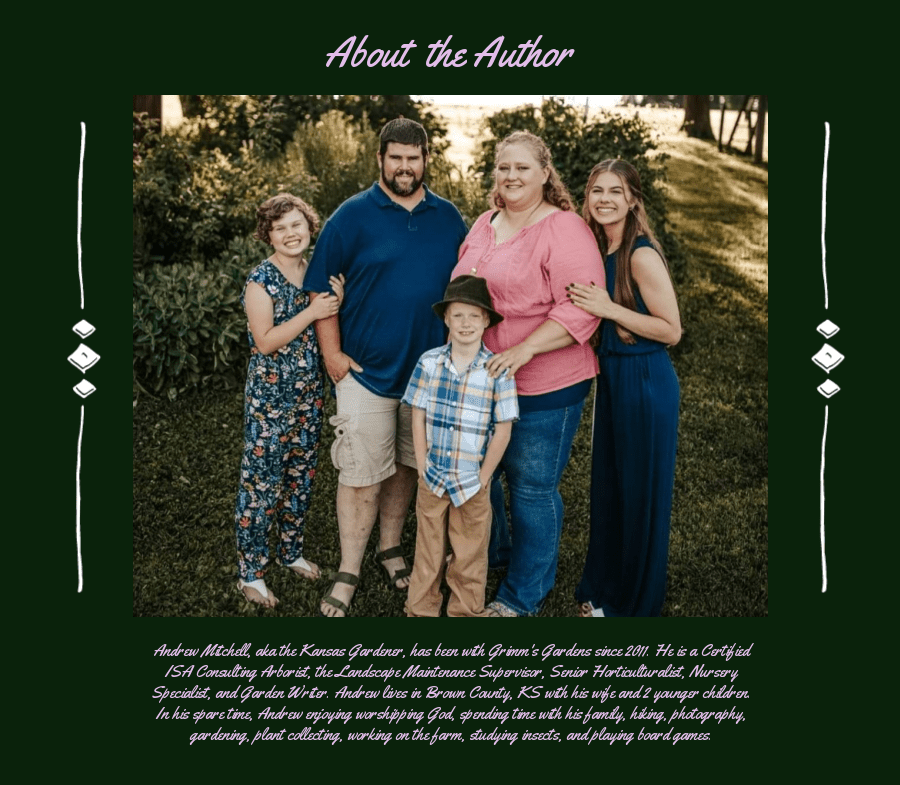What are leps? Leps refers to Lepidoptera, aka moths and butterflies. I love moths, and butterflies too. So I am always looking to add trees, shrubs, and perennials to my landscape which are great for them. With trees, it is hard to find very many that are great for butterflies. Moths yes, some trees are hosts for an astounding number of them. The oak for example, can be a host for 534 species of leps, according to research done by Doug Tallamy in Bringing Nature Home.
I also love trees. Despite growing up in North Central Kansas, next to a prairie remnant, I have an absurd love for trees. My parents planted a windbreak of Scotch and Austrian pines, fruit trees, and maples. They built their homestead next to a creek surrounded by hackberry, red elm, black willow, black walnut, cottonwood, and honeylocust. I spent long hours in those woods, among those trees. And my grandparents planted many different trees, brought back by seed from their travels across the US. So trees are in my blood.
When it comes to choosing trees for leps, there are 5 which I lean to more than others. And it is because of the butterflies they support first, and the moths they support second. Those 5 trees are hackberry, cottonwood, pawpaw, black cherry, and shagbark hickory.
The Hackberry – Celtis occidentalis
Despite a lot of dislike of this tree from my professors in college, I continue to love hackberries. They have always been one of my favorite trees. And I have been vindicated in my love for them, by all the insects and birds which they support. Did you you know that 5 species of butterflies use the hackberry as a host plant in the Central Great Plains? Yes, the mourning cloak, American snout, question mark, tawny emperor, and hackberry emperor all use it.
Besides butterflies, other leps use hackberry as a host plant. There are quite a number of moths, so many in fact, that authorities cannot agree on the number. I have found 7 so far in my studies, but many more are yet to be decided. Because the hackberry is closely related elm, many things that feed on elms, feed on hackberry.
Besides being a great tree for leps, the hackberry is a nice street tree, if you do not mind that almost every year the leaves are covered with a variety of galls. The main gall is the hackberry nipple gall psyllid, but there are around a dozen more gall forming insects which attack the leaves, flowers, and stems. I see galls as a good thing; it means that the tree is desirable for insects, and in turn, birds and other wildlife.
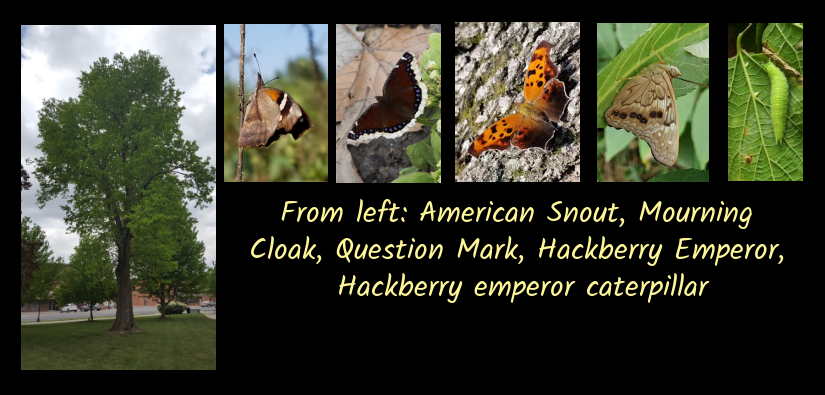
The Cottonwood for Leps – Populus deltoides
One of our former arborists here at Grimm’s Gardens hated the cottonwood. I never did find out why. But it is one of my favorite trees, and it is great for a variety of leps. Besides the many moth species it hosts, there are 3 main butterflies which utilize it as a host plant. Those are the mourning cloak, red spotted purple, and viceroy.
Among the moth leps, the following is a short list of some of the species which us it.
- American lappet
- Blinded sphinx
- One-eyed sphinx
- Common gray
- Copper underwing
- Drab prominent
- Joined underwing
- Tuliptree beauty
- White-marked tussock
- Willow leaftier
- American dagger
I have 2 large cottonwoods in my yard, shading my house from the east. The sound of their leaves in the wind is reminiscent of aspen leaves. They have a distinct tinkling noise, sounding very much like falling rain. I usually hang my hammock under these 2 trees, so I can listen to their sounds. I would not recommend cottonwood as a street tree, because they lose limbs easily. But as a shade tree, they are great.
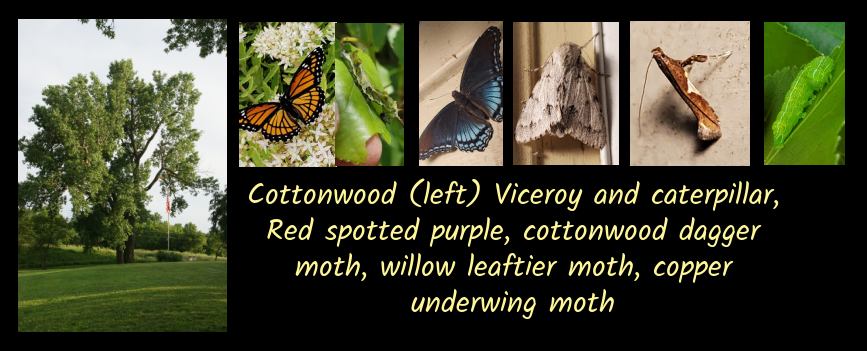
The Pawpaw Tree – Asimina triloba
This is one of the most interesting trees that grows in Kansas. It really looks as if it does not belong here. A very tropical looking tree, it looks like it just came from the jungle. The leaves are quite large, and showy. And the flowers, which can be green, brown, or burgundy hang upside down and are pollinated by flies mainly. But the real part of the pawpaw is the fruit, which is like a small, green banana, with a taste of tropics, like a cross between a mango, papaya, and banana.
But the leps on the pawpaw? There really are not many. However, the main one which is on the pawpaw is the Zebra swallowtail butterfly. This black and white beauty of a butterfly would entrance most butterfly hunters. I spend hours following them around the woods in spring and early summer. Even their caterpillars are cool!
Other leps which use the pawpaw are few. I have only been able to find 2, the pawpaw sphinx moth and the tuliptree beauty moth.
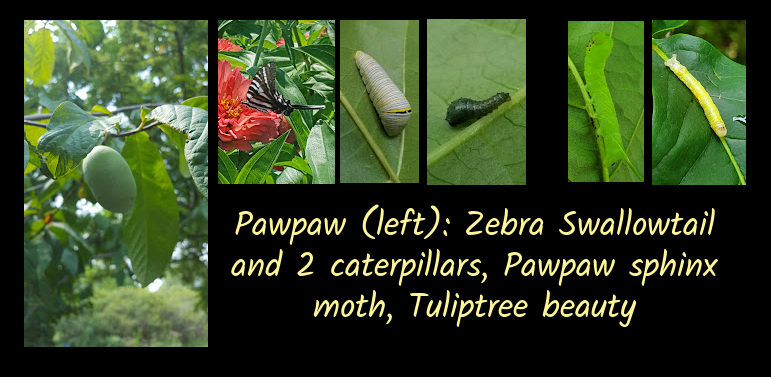
Black Cherry – Prunus serotina
This was a tree I did not know until college, and did not understand until I moved to Northeast Kansas 15 years ago. Growing up in North Central Kansas, there were none, only American plums, sandhill plums, and other plum bushes, not trees. But here, I have black cherry trees growing in my wooded areas, and in the woods around the lake nearby. I can always find something on them. Leps that use it include the following:
- Eastern tiger swallowtail butterfly
- Striped hairstreak butterfly
- Red spotted purple butterfly
- Coral hairstreak butterfly
- Henry’s elfin butterfly
- Copper underwing moth
- Interrupted dagger moth
- Luna moth
- Splendid dagger moth
- Ultronia underwing moth
The black cherry is well known in other circles; its heartwood is used for furniture, flooring and other wood products. Fruit of the tree is used for flavorings, becuase to eat them raw is like eating a cotton ball; they are very astringent. But on the trees in my yard, fruit is hard to come by, because the birds eat it all before I can do anything with it.
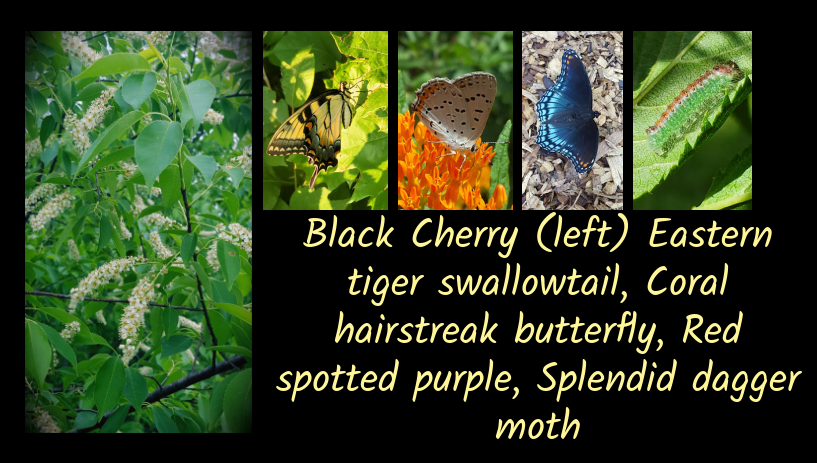
Shagbark Hickory for Leps
I could have used any of the 3 species of hickory common to Northeast Kansas: shagbark, bitternut, pecan. But shagbark is the most common and very ornamental with its peeling bark. It is drought tolerant and makes a good shade tree, though it does not spread out as much as a pecan or an oak. As for leps, there are a variety of butterflies and moths which use it as a host plant.
In may yard, I have seen the benefit of having shagbark hickories in my yard. Butterflies include banded and hickory hairstreaks, and Horace’s duskywing butterfly. Moth leps include American dagger moth, polyphemus moth, luna moth, copper underwing, walnut caterpillar, and yellow-collared slug moth.
Besides the leps, hickories, like the hackberry, have an assortment of gall forming insects which use them. I have been working with some entomologists on iNaturalist to identify rare galls in Kansas, mainly on hickory.
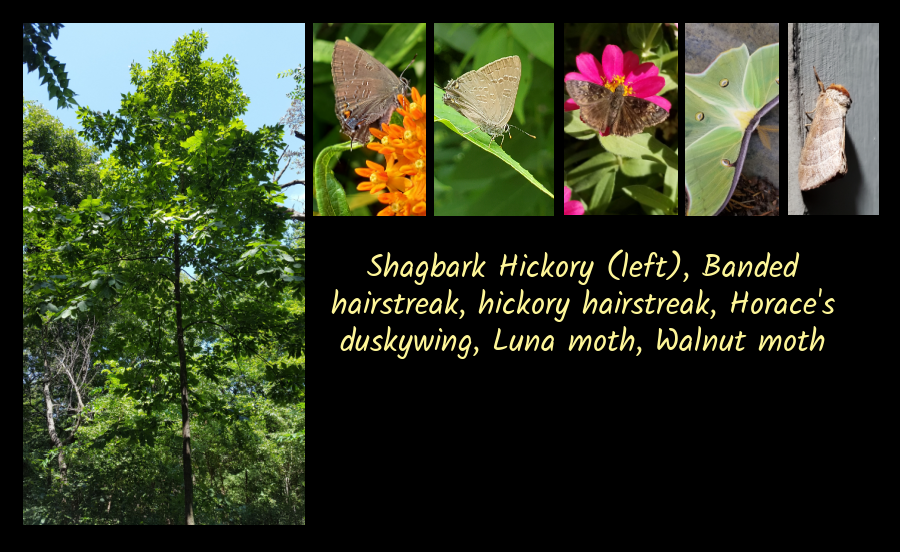
Conclusion
I love my trees, and I love having insects, especially leps on them. The more tree species I can have in the gardens around me the more leps I can support. Between the dozens of species I have now, my trees have the potential to support over 1000 species of moths and butterflies. And with all of those, comes a variety of birds which feed on them through the growing year.
Happy planting!
